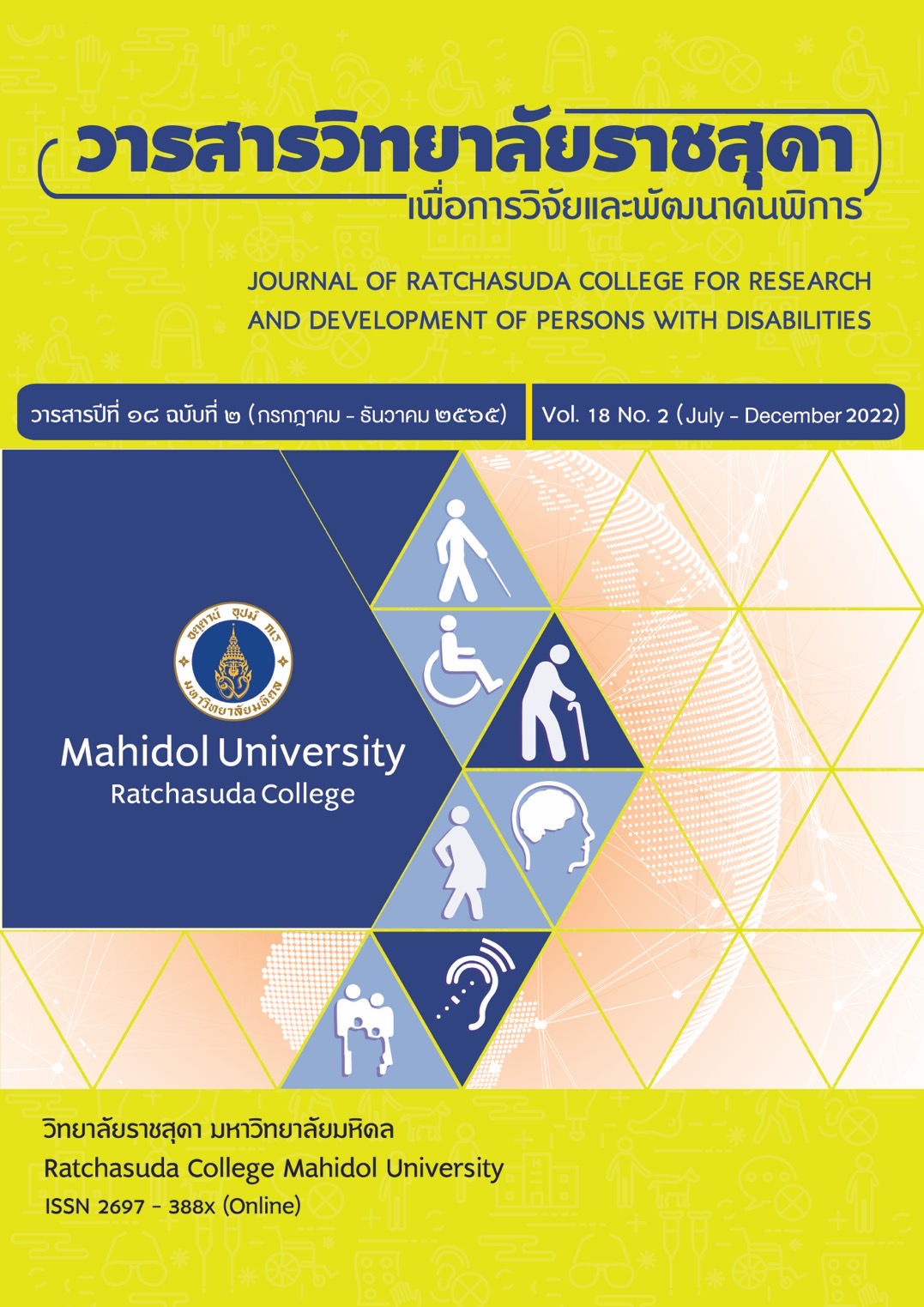Factors affecting educational opportunities and accessibility of an individual with deafblindness
Keywords:
Deafblindness, Educational Opportunities, Educational Accessibilities, Ecological FrameworkAbstract
Deafblindness is a rare and unique condition. Individuals with deafblindness have combined hearing and vision loss, thus limiting their access to both auditory and visual information, which could have inhibitive effects on their learning, communication and mobility in their daily life. This qualitative research aimed to examine factors affecting educational opportunities and accessibilities for the individual with deafblindness. The target group included one individual with deafblindness, three family members, and four teachers. The research tools consisted of a checklist, a non-participative observation form, an in-depth interview form, and a focus group. The data were collected, triangulated, and sorted into categories and summarized by inductive reasoning to achieve the purpose of the research and descriptive presentation. The result showed that all four factors examined, which included issues pertaining to disability; the family; the educational system; and the environment had significant impact on the case study’s educational opportunities and accessibilities. This research indicated that educational opportunities and accessibilities of any individuals with deafblindness are dependent on strong support and collaborative efforts of all relevant persons including interactions with parents, schools, and/or community under the coordination and sustenance of the ecological framework system.
Downloads
References
Aitken, S. A., Buultjens, M., Clark, C., Eyre, J. T., & Pease, L. (2016). Teaching children who are deafblind: Contact, communication and learning. David Fulton Publishers.
Amatyakul, P., Dechongkit, S. & Kachondham, P. (2012). Basic knowledge about disabilities and disabled people (guidelines). Bangkok: October.
Bronfenbrenner, U. (1994). Ecological models of human development. In International Encyclopedia of Education (Vol.3, 2nd ed.1). Oxford: Elsevier.
Chansawang, P. (2017). Children with multiple disabilities. Retrieved from http://taamkru.com/เด็กพิการซ้อน.
Helen Keller Institute for Deaf and Deafblind. (2020). What is multiple disability with visual Impairment (MDVI). Retrieved from http://www.hkidb-mumbai.org/what_is_mdvi.php.
Kyzar, K., Brady, S., Summers, J. A., & Turnbull, A. (2020). Family quality of life and partnership for families of students with deaf-blindness. Remedial and Special Education, 41(1), 50–62.
Limaye, S. (2016). Factors influencing the accessibility of education for children with disabilities in India. India: Tata Institute of Social Sciences.
Manga, T. & Masuku P. K. (2020). Challenge of teaching the deft –blind learner in an education setting in Johannesburg: experiences of educators and assistant educators. South African Journal of Communication Disorders, 67(1), 1-7.
Miles, B. & Riggio, M. (1990). Understanding deafblindness. In Ratchaneekorn Tongsookdee (translator and editor), Remarkable conversations: A guide to developing meaningful communication with children and young adults who are deafblind (p. 20-37). Chiang Mai: Special Education Major, Faculty of Education, Chiang Mai University.
Miles, B. & Riggio, M. (1990). Remarkable conversations: A guide to developing meaningful communication with children and young adults who are deafblind (p. 20-37). (R. Tongsookdee, Trans). Perkins School for the Blind. (Original work published 1990).
Ministry of Foreign Affairs. (2008). Universal declaration of human rights 1948. Bangkok.
National Center on Deaf-Blindness. (2019). 2019 National deaf-blind child count report. Retrieved from https://www.nationaldb.org/products/national-child-count/report-2019/demographics/.
Perkins School for the Blind. (2018). Perkins International. Retrieved from http://www.perkins.org/international.
Phupang, D. (2017). What blind students with multiple disabilities should actually learn? Retrieved from http://www.cfbt.or.th/index.php/article/20-6-3-17-326.
Tantichuwet, P. (2018). The study of in-depth characteristics and factors affecting out-of-school children: A case study of Tak Province. Suthiparithat Journal, 32(101), 80-91.
Taylor, R. L., Smiley, L. R., & Richards, S. (2019). Exceptional students: Preparing teachers for the 21st century. (3rd ed.). New York: McGraw-Hill Education.
The Northern School for The Blind under patronage of the Queen. (2020). Information system. Retrieved from https://www.cmblind.ac.th/th/information-system.
The World Federation of the Deafblind. (2018). First global report on deafblindness. Retrieved from https://senseinternational.org.uk/about-deafblindness/first-global-report-deafblindness.
Tongsookdee, R. (2018). Independent living [Document for the lecture in Subject 070727 Independent living for Individuals with Multiple Disabilities.] Retrieved from Faculty of Education, Chiang Mai University.
Tongsookdee, R., Vittayakorn, S., Leowsiripong, P., Pijai, R., Suparos, W., Tawai, B., Khamruangrith, V., & Sriboonreung, T. (2018). Education management for persons with multiple disabilities in Northern provinces. Faculty of Education, Chiang Mai University.
Downloads
Published
How to Cite
Issue
Section
License
Copyright (c) 2022 JOURNAL OF RATCHASUDA COLLEGE FOR RESEARCH AND DEVELOPMENT OF PERSONS WITH DISABILITIESบทความที่ได้รับการตีพิมพ์เป็นลิขสิทธิ์ของวารสารสถาบันราชสุดาเพื่อการวิจัยและพัฒนาคนพิการ






